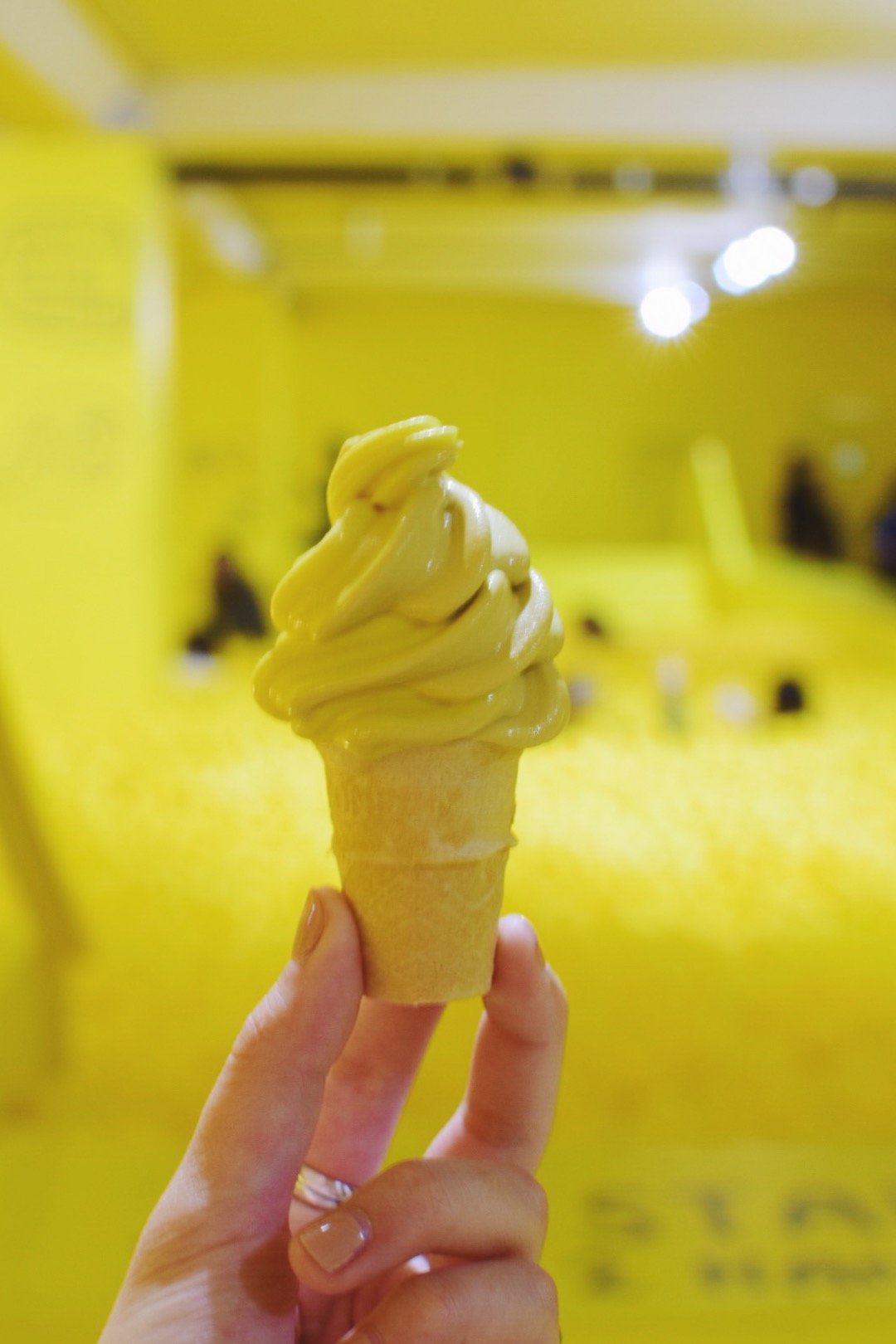A Soulful Recharge at The Color Factory
“Scratch and sniff memory wall by Erin Jang & Leah Rosenberg” an introduction to a colorful experience and sensory overload. Here at The Color Factory, to smell is to remember, and to see is to be supplemented. The colors serve to visualize the imagery evoked by the scent - a threefold, transportive experience. Moving through this room, you prepare yourself for what you’re about to enter: a world of hues, an interactive playground, and a way of experiencing color like never before.
The rooms ranged from projections of individual perceptions of color (think the orange room depicting the black identity by Tosha Stimage) to invitations for the visitor to enact their own interpretation of color (think wadding in a yellow ball pit, in a yellow room, with a yellow ice cream treat to conclude).
Other rooms blurred that boundary in a rainbow haze. The room with rainbow streamers, for example, meant a visual catalogue of t-shirts and bridges and pencil paintings to the artist and playtime for the visitor. In the Color Factory, the visitor was not only a viewer nor a consumer, but an active agent in exploring what color means and what color can do.
Prompted by a sense of urgency to visit this pop up show before it closed so that I could incorporate it into my eventual thesis, I was afforded the trip due to the generosity of Harvard’s History of Art & Architecture Department. Having in mind that I want to write a thesis on color theory (argument and angle TBD), I set my sights on this exhibit not only to explore the various ways in which it engages with color on a unique level, but also because The Color Factory is helping to elevate color as a serious agent of change in the artworld. Here comes my personal vendetta. Last year, I was working on a theoretical exhibition proposal for a seminar on drawings, one in which I wanted to center around color - surprised? I read countless, traditional theories of color, and even stumbled upon a few that enraged me. Namely, a misconception of color as outlined by David Batchelor in the book Chromophobia:
“Chromophobia manifests itself in the many and varied attempts to purge colour from culture, to devalue colour, to diminish its significance, to deny its complexity. More specifically: this purging of colour is usually accomplished in one of two ways. In the first, colour is made out to be the property of some ‘foreign’ body – usually the feminine, the oriental, the primitive, the infantile, the vulgar, the queer or the pathological. In the second, colour is relegated to the realm of the superficial, the supplementary, the inessential or the cosmetic. In one, colour is regarded as alien and therefore dangerous; in the other, it is perceived merely as a secondary quality of experience, and thus unworthy of serious consideration. Colour is dangerous, or it is trivial, or it is both. (It is typical of prejudices to conflate the sinister and the superficial.)” (Batchelor 23)
From that encounter forward, I wanted to personally prove the ways in which color taps into a way of resonating with a viewer that other artistic qualities cannot. To see color is to recognize memory. To be surrounded by color is to have the ability to alter your mood. To walk through the wall to ceiling realms of color in The Color Factory is to experience firsthand the emotive and whimsical powers of color.
Some of the rooms I felt best melded color + senses + experience were the disco ball room and the Chapel. The first being a dimly lit dance party in which shimmers of silvery light twinkled around you as you selected aptly titled songs like Man in the Mirror. In this room, a literal translation of color was applied to connect the visitor to the far-reaching depths of color in other media.
On a more emotional level, the Chapel brought together allusions to stained glass and silence while bridging two rooms of active engagement: the Confetti room where snow angels and sorority sister blow kisses were a must, and the Purple Surveillance room which printed out selfies of people who were aware of the project. In between two “louder” rooms sat this still, reflective space. Where color filtered in and bathed you. Joy and replenishment washed over you. And, for a brief moment, you felt simply thankful to be there.
With an upbeat yellow crescendo to conclude, the Yellow Room featured every monochromatic lover’s dream. From wall to ceiling, everything was yellow and you couldn’t help but feel happy - the ball pit surely helped nudge that sentiment along. But emerging from the exhibit with a yellow ice cream in one hand and a map of secret installations all around San Francisco in the other, I, personally, couldn’t help but feel like my soul was recharged. It’s as if I was re-injected with all the vibrant colors I grew up on in Miami that the classic redbrick vibes don’t quite satiate here in Boston.
And the fun didn’t stop once I left those rainbow doors either. Scattered around the city like a treasure hunt were several other installations, ranging from a mural of favorite foods to a jukebox claiming to showcase what color sounds like.
All in all, The Color Factory served to further the discussion of color’s capacity to be more than a decorative afterthought. But for the conclusion to that argument, you’ll just have to wait to read my thesis.
Xx, Maia




















































